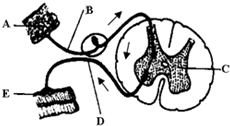如图是反射弧的模式图,箭头代表神经冲动传导的方向.手被针刺后,会发生缩手反射,人也会感到痛.请据图回答(横线上填文字,[]内填字母):
(1)缩手发射是通过一定的神经结构______ 完成的,此神经结构包括五个部分:①A______ ②[______]传入神经 ③神经中枢,位于______. ④传出神经 ⑤E______.
(2)形成痛觉的神经中枢位于______,这说明脊髓不仅有反射功能,而且有______功能.
(3)“望梅止渴”“谈虎色变”等反射是与______有关的反射,也是人类所特有的反射.

(1)反射的结构基础是反射弧,一个完整的反射弧包括感受器、传入神经、神经中枢、传出神经和效应器五部分.根据反射弧的模式图中箭头的方向可知:A是感受器,能接受刺激并产生兴奋能,传导的兴奋就是神经冲动;B是传入神经能将神经冲动传至神经中枢;C是神经中枢,能接受神经冲动,产生新的神经冲动;D是传出神经,能将来自C的神经冲动传至E,引起反射;E是效应器,能接受刺激并作出反应.反射必须通过反射弧来完成,其过程是:感受器→传入神经→神经中枢→传出神经→效应器.缩手发射是简单反射,是生来就有的先天性反射,其反射中枢是位于脊髓的低级中枢.(属于低级的神经活动方式).
(2)当手受到针或火的刺激后会先缩手后感觉到疼痛,形成痛觉的神经中枢位于大脑皮层的躯体感觉中枢,这说明脊髓有反射功能,感到疼痛,是脊髓产生的神经冲动沿脊髓的白质中的传导束传到大脑皮层的躯体感觉中枢,故脊髓具有反射和传导功能.
(3)“望梅止渴”“谈虎色变”引起的反射,与人类的语言文字有关,语言中枢是人类特有的.
故答案为:(1))反射弧;感受器;B;脑干和脊髓;效应器;(2)大脑皮层;传导;(3)语言中枢.
